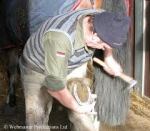The Farrier – Owen Sheers
by Senior reader
In The Farrier Owen Sheers is writing about his inheritance – the Welsh countryside and country life. If the man is smoking woodbines – he uses a small w – they were discontinued in 1988, and this poem is a memory, though it is written as a still life observation.
Sheers’ use of images of colour, touch, and perhaps taste is evocative and vivid. We know from the next poem, Inheritance, that his mother brought him an interest in, an inheritance in horses. Here the horse and the farrier are the focus of the poem; what are we to make of this image?
There seems to be an element of courtship and wooing – he is the romantic lead, later a seamstress, whilst the horse is a bride. He does not look her in the eye, but seems to court her. There is an element of romance, tenderness and love in the relationship between the farrier and nature.
The farrier himself appears to be a far more substantial presence than the horse. His apron the leather black and tan of a rain beaten bay, the smell of woodbine, metal and hoof. When finished, he slaps her, places his tools in their beds. When he touches the horse we are not told what it feels like – as he runs his hand / the length of her neck, checking for dust on a lintel. He folds her leg, leans into her. The horse seems barely there – the hoof, the fetlock, moon-silver clippings echoing the white of the bride’s dress.
The whole scene is romanticised, and whilst the farrier is of this world – the wind twisting his sideburns, his weight as he leans into the horse, the horse – moon silver, walking on strange ground – seems to take on a magical appearance, an apparition of smoke.
With his steel, biting at her heels, the farrier has tamed nature. But this is a nature that is beautiful, romantic, vulnerable. Sheers seems in awe of the beauty of nature, of the man who can control it, and of the fragile, ethereal quality of this horse, the magic of this moment.

[…] Reviews of Skirrid Hill Share this:TwitterFacebookLike this:LikeBe the first to like this post. Leave a Comment by What to read next!! on June 5, 2012 • Permalink Posted in Sheers Tagged Black Mountains Wales, book review, Books, historical novel, Olchon Valley, Owen Sheers, Resistance, Skirrid Hill, WW2 […]
Reblogged this on when dion met english.
Reblogged this on English Literature Reigns ! .
Reblogged this on cathslitblog.
[…] Source: The Farrier – Owen Sheers […]